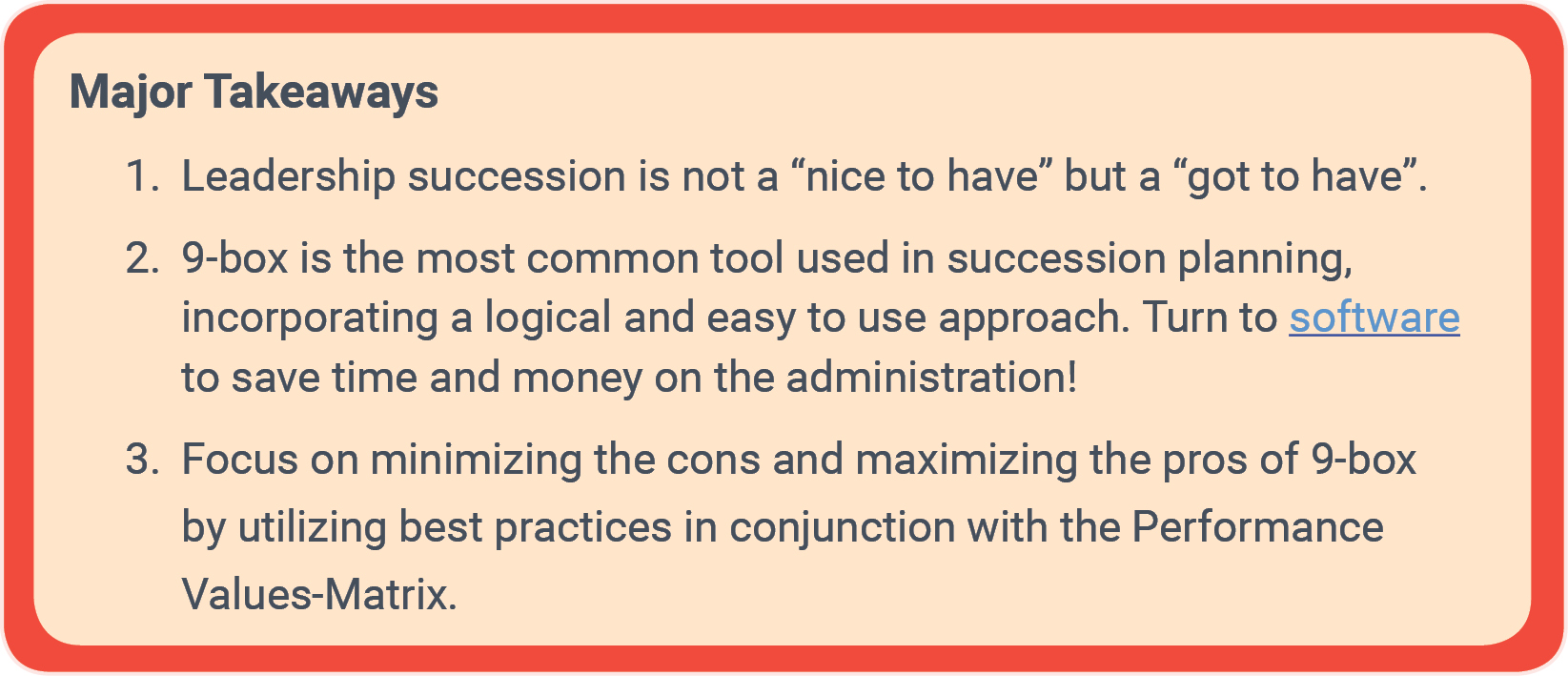Research: 9-Box: Decrease Bias, & Increase Speed & Accuracy with the Performance-Values Matrix
Posted on 08-17-2021, Read Time: Min
Share:
_2inWidth.png)
Leadership Succession
Leadership Succession is the planned practice of identifying future leaders, be it business leaders, C-suite, or other key leaders, within an organization. It is the process of identifying, developing, and then placing talent within the organization. Leadership succession is important for creating business continuity, capitalizing on scale opportunities, avoiding unnecessary costs of hiring, and engaging current employees by developing their career paths.
The 9-box as a Tool for Leadership Succession
This 40+ year old tool uses a two-axis grid approach measuring leadership potential (y-axis) and performance (x-axis). What is the potential for this person to lead people well and for continued growth? How is this person performing in their job? Applying a standard “Low, Medium, and High” rating to each axis creates 3 x 3 possible resulting scores or boxes, hence its generic name, 9-Box.The 9-box approach is a simple, inexpensive tool that utilizes a logical approach to identifying talent and potential successors. While the pros to utilizing this methodology are clear, we must be mindful of the cons: potential for bias or large subjectivity as it may be open to interpretation, aka “plotting then justifying.” The 9-Box methodology can also become a tedious, time-sucking process due to its manual (typically spreadsheet) nature.
Best Practices
Begin to reduce bias and increase accuracy first by clearly defining competencies and measurement scales. This is especially important when evaluating someone’s future leadership potential. Consider the following examples for how to rate leadership potential:Low Leadership Potential: the individual is operating at maximum potential; they are well placed in their role.
Medium Leadership Potential: with additional training and/or mentorship, the individual is likely to develop into a potential leader and successor candidate; they are not ready now, but may be in the future, for managerial promotion.
High Leadership Potential: the individual is operating now in a high leadership capacity, leading self and others well, and shows promise for continued growth.
It’s important to help 9-Box Evaluators understand that “Low Leadership Potential” is not a poor rating. In fact, high performing individual contributors are necessary for an organization to thrive.
This is where the importance of dual career tracks emerge. If the only way a high performing individual contributor can continue growing within an organization and also progress financially, increasing the likelihood of achieving their personal vision, is to become a manager or people leader, the organization runs the very real risk of placing a non-skilled people leader in a people leading role!
It’s also important to develop and provide clear leadership competencies for 9-Box Evaluators to assess against. Start first by identifying what skills and talents (competencies) the identified successor role must possess to be successful and help your organization achieve its goals and fulfill its mission. You may choose to reference the 67 Lominger Competencies, the 177 CliftonStrengths competencies, or the 38 Performance Culture competencies1 such as EQ, Conflict Management, Learning agility, Influencing, and more.
Reduce Bias and Subjectivity
Evaluating potential successor candidates in a silo without easy access to holistic performance and behavior data sets the stage for rater bias and increased subjectivity. A strong performance management process is the foundation for a 9-Box or other Leadership Succession model.At Performance Culture, we believe a solid performance management process begins by developing well-defined, aligned goals. Secondly, it’s vital to train your managers how to truly coach and provide feedback and how to effectively apply your rating methodology. The process wraps up by leading your organization using data-driven decisions that result from the performance review process. Reference our January 2021 webinar through HR.com on “Increasing Consistency and Fairness and Reducing Rater Bias in Performance Reviews”2 for more information.
The Performance Values Matrix (PVM)3 is a management methodology and amazingly powerful visual tool, that, when used in congruence with the 9-Box further enhances and speeds up the process. The PVM allows for both detailed performance and behavior assessment and the quick ability to filter by true “Star” employees within your organization. In theory and in practice, the 9-Boxes are now reduced to only 3 potential placements since Star Employees should already represent high performance attainment.

By the simple use of software! 9-Box by Performance Culture4 allows you to spend more time on the conversations and less time on the administration, setting the stage for your successful Leadership Succession Strategy!

1 https://performanceculture.com/workplace-behaviors/
2 https://performanceculture.com/improve-consistency-fairness-and-reduce-rater-bias-in-performance-revi ews-copy/
3 https://performanceculture.com/the-case-for-the-performance-values-matrix/
4 https://performanceculture.com/nine-box/
Error: No such template "/CustomCode/topleader/category"!

